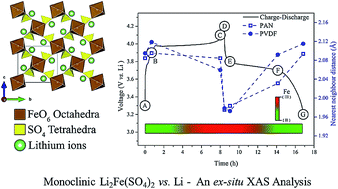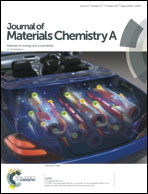Ex situ XAS investigation of effect of binders on electrochemical performance of Li2Fe(SO4)2 cathode†
Abstract
With the objective of moving towards the commercialisation of Fe-based high voltage cathode Li2Fe(SO4)2, the effect of fluorinated binder (polyvinylidene fluoride – PVDF) and non-fluorinated binder (polyacrylonitrile – PAN) was evaluated. First, the redox mechanism involved in the cycling of Li2Fe(SO4)2 cathode in the presence of these two binders was investigated through ex situ X-ray Absorption Spectroscopy (XAS) studies which can directly determine oxidation state changes of the Fe ion during the charge–discharge process. Subsequently, the effect of the binders on the cycling and rate performance was evaluated. In the present work, consistent cycling performance with discharge capacity of 60 mA h g−1 was recorded at low current rate of C/15. However, it was noted that at high charging rate the cell with binder retained only 29% of the discharge capacity in comparison to the cell without binder. This was attributed to the high charge transfer resistance of binders through cyclic voltammogram and electrochemical impedance spectroscopy studies. This in turn suggests the requirement of high conductivity binders for such sulphate based electrodes.



 Please wait while we load your content...
Please wait while we load your content...